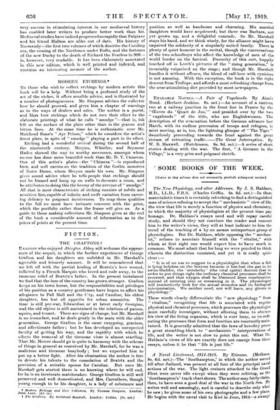MODERN ETCHINGS.* To those who wish to collect etchings by
modern artists this book will be a help. Without being a profound study of the art of the etcher, it offers sensible advice, and is illustrated by a number of photogravures. Mr. Simpson advises the collector how he should proceed, and gives him a chapter of warnings as to the ways of dealers and sales. The author is a purist,' and likes best etchings which do not owe their effect to the elaborate printings of what he calls "smudge "—that is, ink left on the surface of the plate other than in the graven and bitten lines. At the same time he is enthusiastic over Mr. Muirhead Bone's "Ayr Prison," which he considers the artist's finest plate, in spite of " smudge " playing a part in its effect.
Etching had a wonderful revival during the second half of the nineteenth century. Meryon, Whistler, and Seymour Haden showed the way to worthy successors, amongst whom no one has done more beautiful work than Mr. D. V. Cameron. One of this artist's plates—the "Chimera "—is reproduced here, and well carries on the tradition of the Gothic monsters of Notre Dame, whom Meryon made his own. Mr. Simpson gives sound advice when he tells people that etchings should not les framed and hung up on wills to decorate a room, and he attributes to doing this the heresy of the overuse of " smudge." All that is most characteristic of etching consists of subtle and sensitive line, capable of infinite and swift variation from caress- ing delicacy to poignant incisiveness. To reap these qualities to the full we must have intimate converse with the print, which the portfolio rather than the frame will give us. As a guide to those making collections Mr. Simpson gives at the end of the book a considerable amount of information as to the prices of prints at the present time.


































 Previous page
Previous page